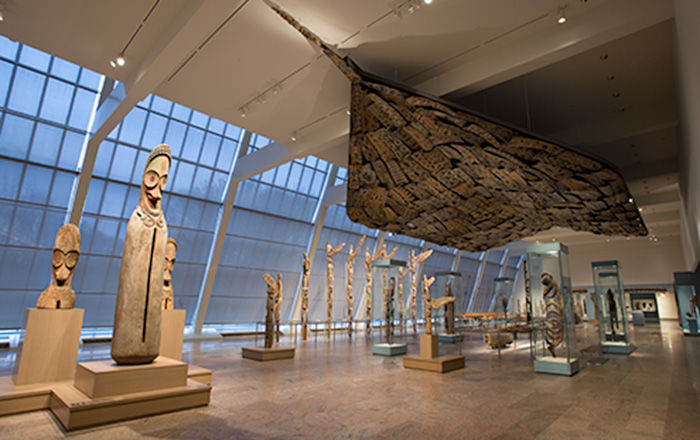Akua 'ba figure
Not on view
The name akua ‘ba (literally, Akua’s child) derives from an Akan legend about a woman named Akua who struggled with infertility. To address her condition, she consulted a priest who advised her to commission the carving of a small wooden child and care for it as she would a living baby, including nursing it and putting it to bed. Despite facing public ridicule with members of her community mockingly calling the figure “akua ‘ba,” her care and dedication to the figure led to a successful pregnancy and the birth of her daughter, which inspired other women to craft similar figurines. Along with conception, akua ‘maa (plural) may be prescribed to prevent complications during pregnancy and childbirth and to avert disease so that the mother and child remain healthy.
The style of this example relates to akua ‘maa carved among the Asante, the ruling confederacy of the Akan. Distinctive features include an elongated forehead on a round head; thin nose; sweeping, arched eyebrows; small, pursed lips; a ringed neck; and large eyes that are identified by narrow slits that slightly protrude from the surface. These features emphasize the feminine ideal for which physical and moral beauty were closely intertwined. For example, wisdom is emphasized through the elongated forehead, and wealth and nourishment depicted through the ringed neck of a well-fed individual. Women would give their akua ‘maa these characteristics in the hope that their daughter would inherit them.
While the majority of akua ‘maa have thin eyebrows that arch out from the center of the face to the edges of its head in accordance with Akan beauty standards, this example has shorter and thicker eyebrows that stay close to the center of the face. Since akua ‘maa were designed with features that mothers wanted their child to inherit, this thicker style of eyebrow may indicate an individual or local beauty standard. could be one of those features. Also distinctive to this example are three holes piercing the edges of the head: one on the top of its forehead and one on each side just below center. These openings would have been used to secure beads around the perimeter of the head. A small string of white beads remains tied around the neck. Prior to the late twentieth century, akua ‘maa were one of the most personal items and the kind of beads used to adorn them could help indicate the owner’s religious affiliation, taste, and wealth. The color white was variously associated with purity, virtue, joy, and victory, qualities that the mother might have wanted for her child.
The back of this figurine’s head has an etched pattern of two horizontal U-shape marks that mirror each other across the central axis and are repeated in an additional row. Many akua ‘maa have one, two, or three rows of this design. The U-shape mark could represent the waxing and waning moon—interconnected forces often associated with regeneration. The crescent moon is a female symbol among the Asante because of its connection to the queen mother, who is understood as the daughter of the moon. She is a powerful figure in state affairs and often complementary to the chief. The moon is also seen as the female aspect of Nyame, the Supreme Creator. As a female symbol, it represents women’s beauty, tenderness, and gracefulness.
This image cannot be enlarged, viewed at full screen, or downloaded.
This artwork is meant to be viewed from right to left. Scroll left to view more.

